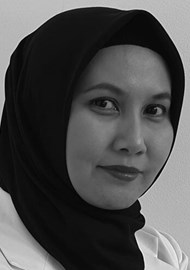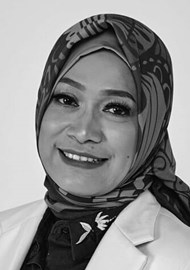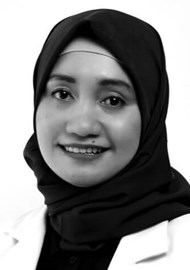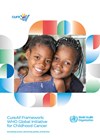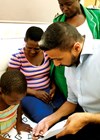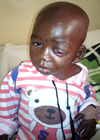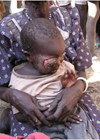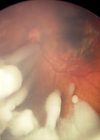In the second article of a two-part series (See Part 1 here), the authors focus on the diagnosis and management of retinoblastoma in Indonesia.
COVID-19 doesn’t get thanked for many things, but on 19 December 2020 as the world grew more Zoom-weary than we could have imagined possible, something significant happened that shifted the game for the management of retinoblastoma (Rb) in Indonesia. Online multidisciplinary (MDT) meetings are not conceptually new, but we have grown used to the irrelevance of physical distance in COVID times, and the online MDT has come of age.
At 12 noon GMT and 7pm (Java; Bandung) and 8pm (Sulawesi; Makassar), Dr Andi Pratiwi and Dr Marlyanti Nur in Makassar and Dr Mayasari Wahyu and Dr Primawita Oktarima in Bandung hosted a meeting at which it was possible to have input to discussions of management of Rb from international experts in multiple countries [1]. As Dr Didi Fabian stated, chairing the meeting, “This format has been tried and tested in Africa and elsewhere, but for a cancer with such high potential survival rates in which the importance of holistic care is essential, this is a significant first for Indonesia.”

Some of the participants in the first online Rb MDT meeting in Indonesia.
Background
In this article we will concentrate on Rb detection, chemotherapy, treatment and in particular the barriers to care in Indonesia. For this, some background on aspects of historical management and healthcare context is helpful. Concern about retinoblastoma care and management in Indonesia began around 10 years ago, with the realisation that a systematic, multicentre approach had not been established. Regional treatment strategies depended on historical links between paediatric, oncology and ophthalmology services. In some centres, a significant barrier to care resulted from a reluctance to engage in risky and toxic chemotherapy treatment courses without biopsy-proven disease. There was a lack of healthy patients / parent exemplars (survivors of Rb) who could testify to the value of the disfiguring but necessary life-saving surgery of enucleation. As a result, there was no national strategy.
Prior to 2014 and the institution of the insurance based National Health System, the Badan Penyelenggara Jaminan Sosial (Social Insurance Administration Organization) BPJS Kesehatan, healthcare was largely urban-centric and economically biased towards those able to afford care. The Posyandu (community health services to the under-fives) generally functioned well, but there was no ‘white pupil’ screening programme and most generalist doctors were poorly trained in the relevance of this to infant health. As a result, referred cases were almost always at advanced orbital stage disease. Given the mortality at this grade, the ‘perfect storm’ of inadequate case detection, late presentation and institutional unpreparedness to treat (surgery and oncology) was perpetuated. Urgent action was needed.
Retinoblastoma detection
The White Pupil Screening programme was started in 2017 in West Java and South Sulawesi. This involved training the Posyandu to incorporate the fundal reflex test into the immunisation programme.

Launch of White Pupil Awareness Campaign in Bandung, West Java 2017.
This project was sponsored by Helen Keller Indonesia (HKI) and has resulted in many patients presenting at a less advanced stage. A meta-analysis published in JAMA Ophthalmology [2] showed that the fundus reflex test has very high positive predictive value for Rb detection. The barrier to care caused by expensive equipment in the form of the direct ophthalmoscope is being challenged by at least one device capable of equivalent or better precision [3].
Retinoblastoma treatment
In Makassar a symposium with international speaker Dr Andrew Blaikie from St Andrews and the head of paediatrics, Professor Dasril, led to the first steps in non-surgical management of Rb. Treatment permissions were granted in December 2013 – agreement to commence chemotherapy without tissue diagnosis, based solely on the clinical finding of calcification on ultrasound and fundoscopy. Around the same time in Cicendo Hospital in Bandung, Java, two clinicians (Dr Primawita Oktarima and Dr Anne Susanty) were sent for an extended fellowship training with Ashwin Reddy and the late Judith Kingston in London, to gain knowledge and skills.

Friska Mardianty and Mayasari Wahyu at the Rb-NET workshop in Hyderabad in 2017.
Representatives from Indonesia participated in the first workshop of the Retinoblastoma Network (Rb-NET) in Hyderabad in 2017 [4], and histopathology expertise was consolidated in Bandung. Following the Hyderabad meeting, a standardised Rb-NET ‘Toolkit’ of management protocols was disseminated, including how to treat persistent disease at the cut end of the optic nerve, management of germ line cases and the role of external beam radiotherapy. Also at that meeting the doses of chemotherapy (standard and high dose) were agreed and published [5]. In Uganda Dr Keith Waddell [6] described using chemotherapy in resource poor settings with impressive results, and there is no reason why similar success rates could not be achieved in Indonesia. In 2020 it was possible for the National Eye Centre – Cicendo Eye Hospital to commence chemotherapy in its own unit, rather than relying on onward referral to a general hospital. The Rb-NET supported by the Queen Elizabeth Diamond Jubilee Trust proved invaluable.
Retinoblastoma outcomes
An observational study was conducted at Wahidin Sudirohusodo Hospital and Hasanuddin University Hospital (the main referral hospitals in Eastern Indonesia) examining five years of retinoblastoma secondary care data from medical records up to 2019. Ninety-one patients with Rb were recorded as having been seen during that period. The number of patients presenting with Rb remained relatively steady across each of the five years, with 42% of eyes intraocular, 51% orbital, and the remainder phthisical or missing data. Bilaterality was high at 32%.
Obtaining parental consent to enucleation is still a significant problem, and understandable emotional abhorrence is overlain with some cultural reluctance. Of the total patient group, three had enucleation alone, and a further 26 when combined with chemotherapy (total 32% plus two exenterations). Chemotherapy alone (monotherapy) was the treatment of choice for 48 patients (53%) and a further 12 patients refused treatment or were lost to care and follow-up (13%).
The survival rate in patients treated with neo-adjuvant chemotherapy was still low, with one-year and five-year survival rates of 38.04% and 3.26%, respectively. These data reveal that there are still gaps and challenges. This mainly relates to lack of awareness among the community, poor referral systems, non-standardised management protocols, lack of financial and insurance support for chemotherapy agents, and poor data / follow-up.
This result showed the necessity of a multidisciplinary collaborative approach, and international networking or discussion forum with experts from other countries to broaden our knowledge in holistic retinoblastoma care, hence the Rb-NET meeting.
Data from Cicendo in Java (2017 to 2020) provided a larger population and mirror some of these findings. A total of 143 cases were seen. As in Makassar this was steady across the years apart from an unfortunate but possibly expected dip in 2020, presumably due to complex healthcare messages relating to COVID-19 tragically reducing referrals.

Participants in the Rb-NET workshop.
It seems likely that delays in chemotherapy treatment commenced off-site will now be considerably reduced or eliminated, as careful audit presented in a timely manner revealed roadblocks to the previous standard of care off-site. Data from 2018 onwards are being analysed and some data were submitted to the worldwide review of incident cases in 2017 published in JAMA Oncology, where approximately half the incident cases in the world were accounted for [7]. As a metric of the rate, a simple headline statistic is the survival in 2017 of 35 out of 41 children (85%), which is highly encouraging.
Where next?
Remaining challenges include regional variations in funding for chemotherapy – in some areas charitable funding is needed and in others government resources are available. In any case, in an archipelago nation with massive geographical catchment areas being served by satellite tertiary centres, families will often need to remain in or at the hospital for extended periods for cycles of treatment. More than anything else this group of patients and families need psychological, social and emotional support, including play therapists and social workers, an excellent prosthetic service and, in time, a network of successfully treated patient advocates. Currently most of the world literature relates to intraocular disease and there is a need for carefully worked palliative management strategies and possibly for Delphi consensus for late presentations of the more advanced cases (with extraocular disease) [8].

Mayasari Wahyu and Sesy Caesarya with a patient and carer at Cicendo Eye Hospital, Bandung.
Indonesia is well placed to lead the world in developing these management protocols whilst looking forward to a time when any guidance so written can be confined to history, never to be needed again. In the JAMA review of 4351 worldwide cases in 2017, 49.1% of cases presenting in low-income countries had extraocular tumour at time of diagnosis, compared with 1.5% in high income countries [6]. For some time to come then, and in Indonesia at present, whilst beyond doubt there is the national move to worldclass care and early case detection, such guidance will be needed. We know where the road leads in aspirational survival rates. We know early detection is possible and community case finding essential. We know that resource poor settings [5] have achieved astonishing gains. We understand the value of international collaboration and support and the Rb-NET has proved invaluable. Bringing together world expertise is the only way to make progress. So, for once, a positive response to the COVID-19 pandemic.
References
1. Retinoblastoma Network website:
https://www.rb-net-mdt.org/
2. Subhi Y, Schmidt DC, Al-Bakri M, et al. Diagnostic Test Accuracy of the Red Reflex Test for Ocular Pathology in Infants: A Meta-analysis. JAMA Ophthalmol 2021;139(1):33-40.
3. Tuteja SY, Blaikie A, Kekunnaya R. Identification of Amblyogenic Risk Factors with the Brückner Reflex Test using the low-cost ‘Arclight’ Direct Ophthalmoscope. Eye 7 Jan 2021; Epub ahead of print.
4. Williams P, Bowman R, Foster A, et al. Rb-NET: a network to save life and preserve vision in children in Africa. Eye News 2018;24(6):32-4.
5. Ashwin Reddy A, Jain M, Khetan V. Managing and treating intraocular retinoblastoma. Comm Eye Health 2018;31(101):14-6.
6. Waddell KM, Kagame K, Ndamira A, et al. Clinical features and survival among children with retinoblastoma in Uganda. Brit J Ophthalmol 2015;99:387-90.
7. Global Retinoblastoma Study Group. Global Retinoblastoma Presentation and Analysis by National Income Level. JAMA Oncol 2020;6(5):685-95.
8. Ketteler P. Paediatric Haematology and Oncology, Essen; Rb registry coordinator. Personal communication 2021.
COMMENTS ARE WELCOME


